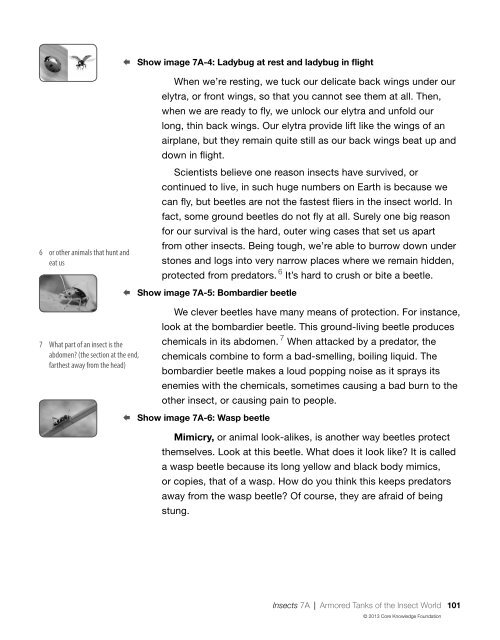Read-Aloud Anthology - EngageNY
Read-Aloud Anthology - EngageNY
Read-Aloud Anthology - EngageNY
You also want an ePaper? Increase the reach of your titles
YUMPU automatically turns print PDFs into web optimized ePapers that Google loves.
Show image 7A-4: Ladybug at rest and ladybug in flight<br />
6 or other animals that hunt and<br />
eat us<br />
When we’re resting, we tuck our delicate back wings under our<br />
elytra, or front wings, so that you cannot see them at all. Then,<br />
when we are ready to fly, we unlock our elytra and unfold our<br />
long, thin back wings. Our elytra provide lift like the wings of an<br />
airplane, but they remain quite still as our back wings beat up and<br />
down in flight.<br />
Scientists believe one reason insects have survived, or<br />
continued to live, in such huge numbers on Earth is because we<br />
can fly, but beetles are not the fastest fliers in the insect world. In<br />
fact, some ground beetles do not fly at all. Surely one big reason<br />
for our survival is the hard, outer wing cases that set us apart<br />
from other insects. Being tough, we’re able to burrow down under<br />
stones and logs into very narrow places where we remain hidden,<br />
protected from predators. 6 It’s hard to crush or bite a beetle.<br />
Show image 7A-5: Bombardier beetle<br />
7 What part of an insect is the<br />
abdomen? (the section at the end,<br />
farthest away from the head)<br />
We clever beetles have many means of protection. For instance,<br />
look at the bombardier beetle. This ground-living beetle produces<br />
chemicals in its abdomen. 7 When attacked by a predator, the<br />
chemicals combine to form a bad-smelling, boiling liquid. The<br />
bombardier beetle makes a loud popping noise as it sprays its<br />
enemies with the chemicals, sometimes causing a bad burn to the<br />
other insect, or causing pain to people.<br />
Show image 7A-6: Wasp beetle<br />
Mimicry, or animal look-alikes, is another way beetles protect<br />
themselves. Look at this beetle. What does it look like? It is called<br />
a wasp beetle because its long yellow and black body mimics,<br />
or copies, that of a wasp. How do you think this keeps predators<br />
away from the wasp beetle? Of course, they are afraid of being<br />
stung.<br />
Insects 7A | Armored Tanks of the Insect World 101<br />
© 2013 Core Knowledge Foundation

















